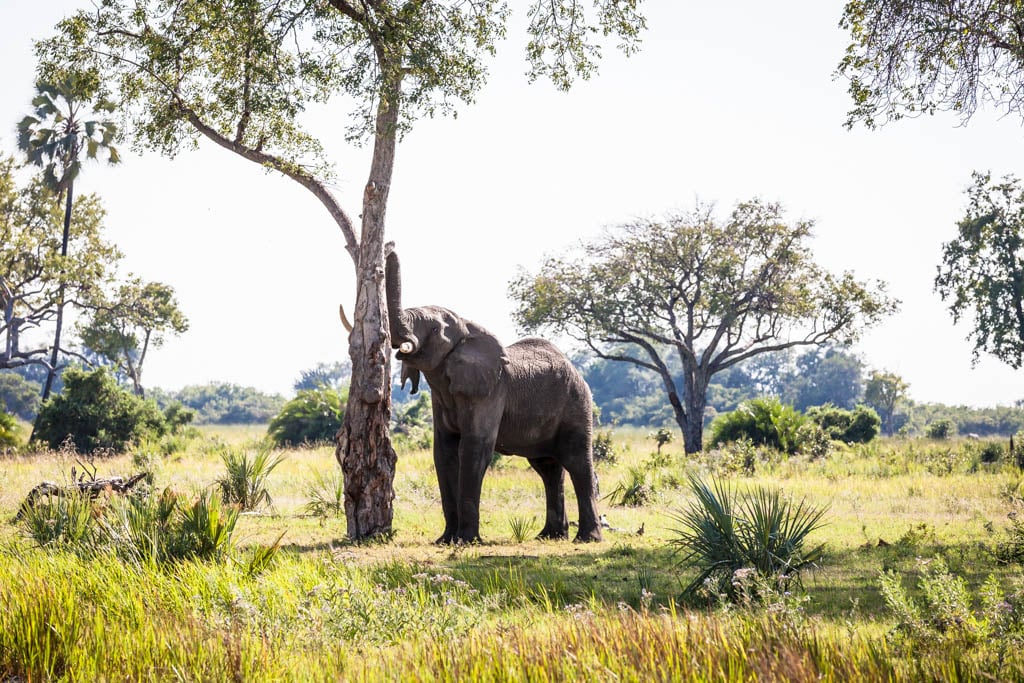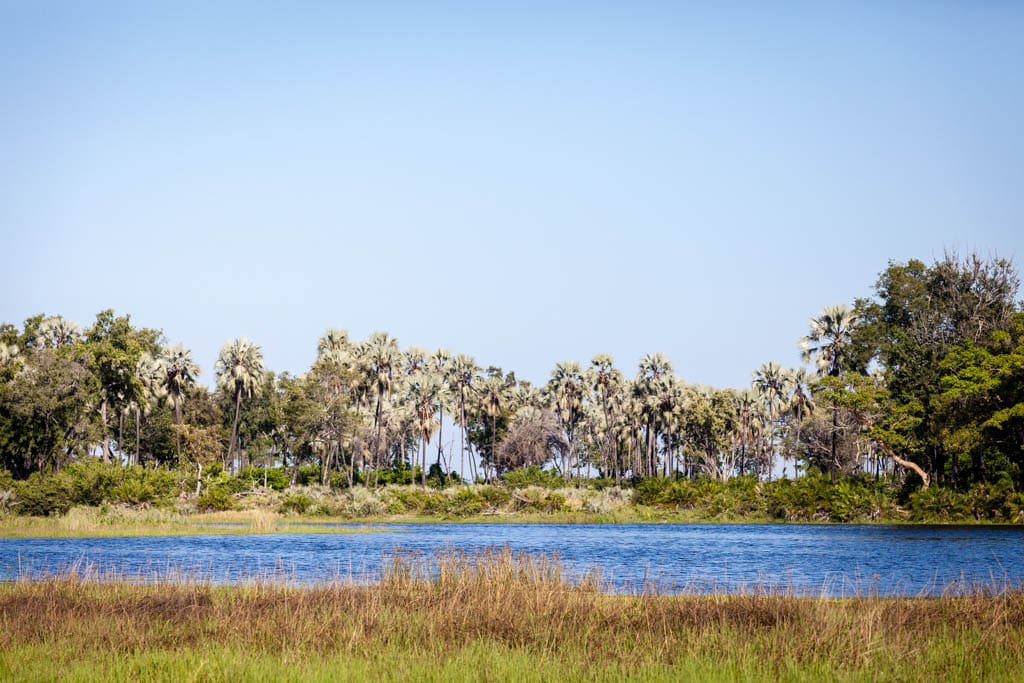The first time an African elephant charged at me I was encased in the safety of a safari jeep. Although the 5,000 kg giant came at the jeep with surprising speed, shaking his head from side to side, ears flapping back and forth in a display of admonition, I knew I was relatively safe in the confines of our jeep. Now, as I hear our guide, TH, instruct us to move quickly – but do not run – in the opposite direction of the large male elephant who is charging at us, I do not feel that sense of security. That’s because my insignificant-by-comparison bodyweight of 60kg is on the ground in an open field, my only refuge a single palm tree a few hundred meters away. Myself, my husband, and one other couple are on a guided walking safari on Palm Island, a small island in the Okavango Delta.

This is my first ever walking safari in Africa and I’m beginning to realise that being on the ground with the wildlife is a very different experience to that of the more traditional jeep safari. ‘’S’okay’ says TH motioning that it’s ok for us to stop again. Evidently, the elephant was ‘playing’ with us and had only mock-charged our group, a warning that he knows we are here. I turn back to face the elephant, watching in awe as he gracefully makes his way through the bush towards the Marula tree he has eagerly been approaching. ‘The elephants use their trunks to shake the Marula fruit from the branches,’ says TH. As if on cue the elephant lifts his trunk and pulls at a branch. The rustle of the leaves as the tree is stripped of its fruit is the only sound that fills the air. And it’s surprisingly loud.

The world seems slower on the ground, more peaceful. A walking safari is a far cry from a jeep safari. There’s no grunt from an engine to alert the wildlife to your presence, no crowds of tourists clicking away on their cameras. The emphasis on a walking safari is on the smaller aspects of nature that may otherwise go unnoticed: plants, insects, birds, and how nature works together.
TH reaches for the binoculars that dangle from around his neck to survey the area ahead. He must have deemed it safe for we continue on into the depths of the island. We’ve been instructed to wear long pants and closed-in shoes on our walk and as we venture deeper into the bush it’s clearly evident why. There are no paths, it’s untamed land. TH is forging our own ‘path’ through waist high grass that’s bedded down in the sloshy mud of the Delta.

The aroma of fresh elephant dung pierces my nostrils. Just ahead of us the tall grass has collapsed, parted by one or more elephants who have taken this route; not too long ago judging by the steaming dung that’s peppered along their trail. TH reaches down and picks up a handful of the dung. ‘Do you see, the food is mostly undigested?’ he says, massaging the mass between his fingers. What is still recognisable as grass falls to the ground, a single Marula fruit, which is very much still intact, is left in the centre of his palm. I cringe at the sight, but am amazed at this unusual talent the elephants have.
TH, like most of the guides in Africa, is full of knowledge about the land, the wildlife, how it all works as one. How one person can be so knowledgeable about so many different aspects of nature is inspiring. How he retains all of the information: plant names, their uses, the history of the Delta, its wildlife and their behaviour, is beyond me. I have a hard enough time remembering the name of the three different bird species he pointed out to us on the way to the island that morning.

Elephants, TH tells us, do not have very good eyesight. They rely heavily on scent and sound. ‘These elephants were here not long ago,’ he says almost to himself as he raises the binoculars to his face again. ‘There.’ He points to a cluster of trees to our left where three elephants, one female and two babies, are slowly making their way across the island towards a lagoon, grazing as they go. ‘We need to stay downwind of them,’ he says. So, in single file we continue on inland being careful to stay well clear of the elephants’ path.

TH has paused next to a pretty plant with purple flowers that he tells us is a Cornflower plant. As we’re standing there listening to TH tell us about the many uses a Cornflower plant has a group of baboons saunter through the grass to our right. One large male fronts the group and several females and lower-class males trail behind, with a few babies straggling behind trying to keep up with the group. They pass us by like we’re invisible, with only one bothering to cast a glance in our direction. The wildlife here is mostly blasé about our presence with the majority of them barely taking the time to acknowledge us, save for the elephant.

I find myself asking TH whether he’s ever encountered a lion on a walking safari. ‘Yes,’ he says matter of factly. ‘If we are lucky we might see one, though it’s rare on this island.’ The fact that we are in the wilds of the African bush sans gun for protection is not lost on me. I’ve asked a guide once before what they do if they come across a lion on the ground, after all none of the guides have carried guns. ‘We use this,’ he’d said, gesturing to his head. I can’t help but wonder if I’ll be brave enough to keep my feet planted on the ground as I’m supposed to in the event of a lion encounter. Fortunately, or not depending on how you see it, I don’t get the chance to find out this time.
On the way back to our boat TH points out that the Marula-entranced elephant we encountered at the start of our walk is still by his tree. The baboons who so graciously ignored us a short time ago have also been taken under the tree’s spell; they dance from branch to branch in search of the fruit. ‘Nature works together,’ says TH as he point out the Marula fruit falling to the ground, the elephant eagerly collecting his bounty. This tiny detail would go unnoticed to an untrained eye. As I watch one of the smallest animals on the island work in unison with Africa’s largest land mammal, I’m in awe of nature. I just nod to TH and watch, speechless at nature’s beauty.
That’s the thing about Africa though. It ignites your senses, changes the way you see the world, and leaves you with insufficient words to describe its beauty.






Very interesting and informative article. Great writing Sarah.
Great post, Sarah! I haven’t gone on a walking safari (YET), but I did a safari from Cape Town to Dar Es Salaam!
I saw Table Mountain, traveled through the Namib desert and saw the magnificent Victoria Falls! It was one of the best trips I’ve ever taken, and I’m already planning my next one!
If you’re interest, the trip I took is called “African Encounter | 36 Days Cape Town To Dar Es Salaam” (https://africatravelco.com/trip-and-safaris/cape-town-dar-es-salaam-36-day-tour/), I highly recommend it!